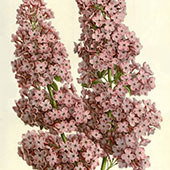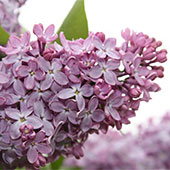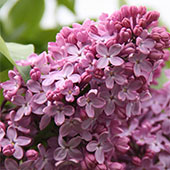Libert-Darimont, 1858
‘Dr Lindley’, S. vulgaris
Darimont 1858; S IV
syn. – ‘Doctor Lindley’, ‘Lindley’, ‘Lindleyi’, ‘Lindleyana’ (also ‘Louis van Houtte’ according to Wister, 1953)
{parentage not known}
L. van Houtte in Fl. Serres, 14:237, t. 1481-1482 [1861]; McKelvey, The Lilac, 289 [1928]; Wister, Lilacs for America, 47 [1942], 28 [1953]; Photo on Jorgovani/Lilacs 2015 DVD.
Named for John Lindley, 1799-1865, British botanist.
cultivar name presumed registered 1953; name established and accepted.
Международный регистр названий культиваров рода Syringa L.
Dr. Lindley Van Houtte in Fl. Serres, XIV. 237, t. 1481, t. 1482 (1861), “Void le plus beau des Lilas; ses magnifiques thyrses très-denses, d’un purpurin brillant, dépassant ceux de toutes les variétés connues, tant sous le point de vue de volume, des dimensions hors ligne de ces gigantesques bouquets, que sous celui de la perfection dans la forme des corolles,” as Lindleyi and as Lilas du Dr. Lindley. — A. Leroy, Cat. 1865, 100, as Syringa Lindleyana and as Lilas de Lindley. — Horticulturist, 1874, 265. — L. Leroy, Cat. 1876, 72, as Syringa lindleyana. — Ottolander in Sieboldia, II. 187 (1876). — Wiener Obst-Garten-Zeit. 1. 564 (1876). — Carrière in Rev. Hort. 1877, 359, as Docteur Lindley. — Baudriller, Cat. no. 43, 142 (1880), as Lindleyana and as Lilas commun docteur Lindley. — Dieck, Haupt-Cat. Zöschen, 77 (1885). — E. Morren and A. De Vos, Index Bibliog. Hort. Belg. 556 (1887), as Lindleyi. — L. Henry in Jardin, VIII. 175 (1894), as Docteur Lindley; in Jour. Soc. Hort. France, ser. 4. II. 733 (1901), as Docteur Lindley.—Voss, Vilmorin’s Blumengartn. 652 (1896), as Doctor Lindley.
Since the name Dr. Lindley is commonly used in referring to this form, to avoid confusion it has here been retained rather than the Latinized name Lindleyi used also by Van Houtte.
Van Houtte states that this is a seedling obtained by Dr. Darimont [probably the Dr. Libert-Darimont who is said to have produced the form Azurea plena] and put in the market by the Van Houtte firm about 1859. Carrière writes later, apparently in ignorance of this statement, that the origin of this Lilac is unknown; he thinks it is probably English and imported by Makoy of Liège, Belgium, a long time previous to the date at which he writes. He believes that it was Bertin the elder of Versailles who first introduced it to France, about 1864.
The two plants whose descriptions follow both bear this name but are not the same in appearance and I am uncertain which is true to name.
Notes on plant in Arnold Arboretum (grown from cuttings taken June 7, 1895, from plant received from Späth in January, 1888; no. 2975-1 Am. Arb.). Flowers single, symmetrical, medium to large in size; tone intermediate to pale; color in bud Deep Hellebore Red to Daphne Red to Tourmaline Pink (XXXVIII); when expanded Tourmaline Pink to Laclia Pink marked with Pale Laelia Pink (XXXVIII.) on margins without, Lilac (XXV.) within. Clusters compact, medium size.
Notes on plant in Dept. of Parks, Rochester, N. Y. (received from Ellwanger and Barry in 1892). Flowers single, large; corolla-lobes cucullate, rounded at apex, symmetrical; tone intermediate; color in bud Magenta (XXVI.); when expanded Eupatorium Purple to Laelia Pink (XXXVIII.) without, Rose Purple marked with Pale Rose Purple (XXVI.) within. Clusters compact, pyramidal, medium size. The flowers appear to be darker without than within.
“THE LILAC: A Monograph” Susan Delano McKelvey, MacMillan, New York, 1928
Др. Линдли Dr. Lindley (Lindleyi) (Libert, 1858)
Цветки синевато-фиолетовые, мелкие, простые. Соцветия из одной-двух пар пирамидальных, очень редких, довольно прочных метелок размерами (16-18)х8 см. Листья темно-зеленые. Кусты средней высоты. Цветет обильно, но непродолжительно, в средние сроки. Возможно, форма дикорастущей С. обыкновенной.
«ВИДЫ И СОРТА СИРЕНИ, КУЛЬТИВИРУЕМЫЕ В СССР» Л.И. Рубцов, Н.Л. Михайлов, В. Г. Жоголева, Киев, Наукова Думка, 1980




Оставить комментарий
Пожалуйста, зарегистрируйтесь, чтобы иметь возможность оставлять комментарии.